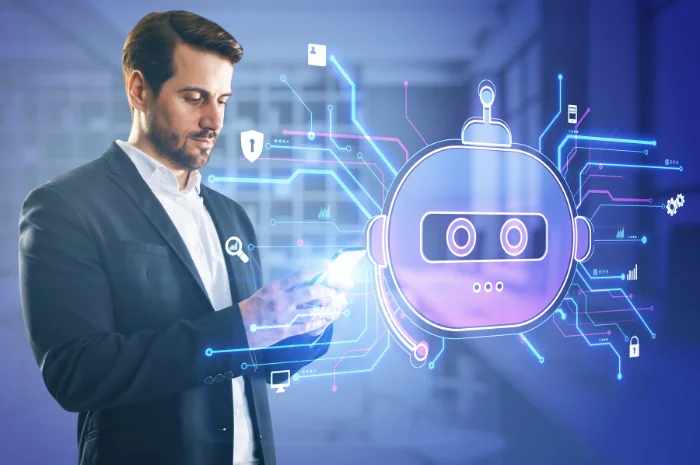What is robotic process automation RPA – Time is money, as we all know in any business. Almost every company has a number of operating sections that conduct hundreds of jobs on a daily basis. In this sense, the fierce rivalry among businesses and the widespread desire to boost productivity are more important than ever. RPA (robotic process automation) can help with this. According to an RPA industry overview report, the total automation market was estimated to be valued at around $1.3 Billion in 2019, and by 2027 it is estimated to reach a whopping $12 Billion in market value. This shows the exponential growth of the automation market.
The use of robotic process automation (RPA) is transforming the way businesses are run. RPA software robots, for example, can assist reduce the requirement for human labor to execute specified activities while still achieving a high degree of ROI. Furthermore, employees spend 10% to 20% of their daily time on repetitive computer chores, which has a substantial impact on their productivity. Robotic Operation Automation (RPA) software, on the other hand, may automate any process by 60-80%. So, in this blog, we’ll see how businesses can choose the right processes for incorporating RPA in their operations. If you want to know what is robotic process automation rpa, read in detials below.
What is RPA?
What is RPA – RPA, in a nutshell, is the process of automating business operations. Software robots can help you save time and decrease the risk of a human mistake by automating regular operations for your personnel.
This, of course, excludes physical robots. RPA meaning is more about software programs that automate time-consuming tasks. In other words, RPA mimics human actions and accomplishes tasks, freeing up your staff to focus on more important tasks like dealing with customers or developing company plans.
Selecting the right processes for RPA
RPA is gaining traction slowly but steadily. Certain businesses, on the other hand, are at a loss when it comes to identifying and selecting the suitable processes for RPA since some activities are better suited for automation while others are not. Implementation is not the same as strategizing. Prior to deployment, internalizing a technology and establishing the appropriate procedure for the activity necessitates a great deal of thought. Manual, repetitive, and rule-based procedures, on the other hand, are more suited for RPA.
There are certain reservations about using RPA at a corporate level. Using solutions for RPA automation at the desktop level does not equate to enterprise-level automation. According to statistics, 30- 50% of initial RPA deployment efforts fail. As a consequence, companies are bewildered as to how to get the intended outcomes after investing in technology. In order to get a good outcome, the company must first choose the right method. They must also explain what should and should not be anticipated from the implementation. RPA, for example, will increase the processing speed by at least 5 times. Simply defined, in order to adopt RPA, a company must first determine the criteria that would allow them to “choose the proper process for automation.”
So, here is the list of the primary types of processes that can be selected for RPA and are to be transformed using the same:
- Rule Drive Processes – Business processes that are rules-driven as well as consistent are a good choice for RPA implementation.
- Repetitive Tasks – Manual and repetitive tasks decrease productivity significantly, therefore these are an ideal fit for robotic process automation RPA implementation.
- Electronic Triggers – Business processes that initiate after the reception of electronic files such as MS Word, HTML File, etc. can be automated.
- High Error-prone processes – Business processes that involve manual interference such as data entry can be automated as they pose a high error probability.
- Processes involving manual calculations – High-intensity tasks that involve manual calculations where one error might lead to another and then another can be automated to ensure precise results.
- Out-of-hour tasks – Tasks that are to be carried out irrespective of timings such as issue resolving, order processing, etc. can be automated.
- Digital interference processes – Processes that involve digital input/output can also be automated.
- High Compliance Processes – Processes that necessitate audit evidence in order to meet regulatory requirements.
- Validation Processes – Tasks that require validations at each synapse and involve numerous systems.
- Resource Intensive Processes – Tasks that need a large number of resources and several steps.
Examples of Processes that can be automated using RPA
- Client Support Activities
RPA solutions aid in the transformation of client interactions. This aids in the simplification and acceleration of the application evaluation process. You utilize RPA to automate each validation of data connected with a customer profile and retrieve the appropriate data sets, eliminating the requirement for a person to transfer between apps.
- Sales Orders Processing
Entering data into CRM systems, updating ERP reporting, and looking for orders are all common trading procedures. By automating operations like filling sales orders, invoicing, and more, RPA may leverage client forms for any sales activity. Furthermore, RPA programs aid in the maintenance of a clean database, the improvement of customer service, and the motivation of your sales team to achieve greater outcomes.
- Invoice Processing
Processing invoices on a daily basis may be time-consuming and exhausting. Workers are well aware of the time and effort required to manually handle various file formats, awkward email attachments, and other time-consuming tasks. RPA assists in swiftly locating files and analyzing employee bills without the need for human participation.
Also, read – Ultimate guidelines to a successful RPA implementation
Conclusion
The potential for RPA is limitless, which can be a barrier to realizing and scaling its value. However, defining your criteria, objectives, and a framework for success can be the difference between a shaky attempt and a solid implementation set for scale to realize the value of RPA and the return available.



